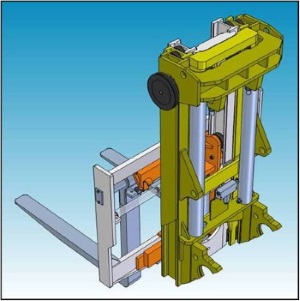Forklift feature articles
The largest forklift operator training website in the world
![]()
![]()
Complete Instructor's training slide set, 130 slides, £50

Mast, forks and warranty
Following on from the previous page the next three items to be checked are the mast, the forks and carriage and the warranty being offered.
7. Mast condition and operation
Check for smooth mast operation, with and without a load. The mast should not ‘bind’ (stick) and there should be no play in the mast channels or between the fork carriage and mast. Masts and chains must always be checked by a competent person.
Look out for any creeping down or creeping forward of the mast when loaded. This could be a sign of seals, ram or valve problems. Check that the rating plate on a truck refers to the mast and any fitted attachments. During the course of a truck’s life, the mast may have been changed. This is often overlooked. If there is a sideshift, check whether it’s operating smoothly and not sticking when loaded.
8. Forks and fork carriage
Examine the truck’s forks for damage or wear, paying special attention to:
- Thickness at heel: The minimum should be specified by the truck’s manufacturer. But, If this is not available, it should be in accordance with ISO5057.
- Fit: A loose fit could indicate worn carriage or hanger points.
- Cracks: Visually check for cracks on the arms at heels and mountings
- Examine the fork carriage for excessive wear.
9. Check the forklift truck's warranty
Always ask to see a truck’s warranty documents, paying special attention to:
- How much warranty is being offered
- What the warranty covers
- What the exclusions are
For additional security, you may wish to request an additional warranty on the battery. Batteries are very expensive to replace. Importantly, most warranties apply to new trucks with some terminating upon resale.